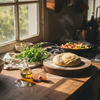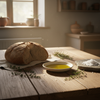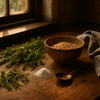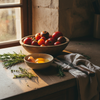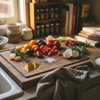Silicone Ladle Guide: 5 Features Every Chef Needs
Your ladle just melted again. We've all been there—watching our trusty kitchen tool surrender to the heat of a simmering pot, leaving behind a plasticky mess that definitely doesn't belong in tonight's soup. Enter the game-changer: the silicone ladle.
Key Takeaways
- Traditional ladles often melt when exposed to high heat, causing inconvenience in the kitchen.
- Silicone ladles are designed to withstand high temperatures without deforming or melting.
- Using a silicone ladle can prevent unwanted plastic residues in your food.
- Silicone ladles offer durability and reliability for everyday cooking tasks.
Table of Contents
A silicone ladle isn't just another kitchen gadget—it's your ticket to fearless cooking. Made from food-grade silicone that can withstand temperatures up to 600°F, these tools have revolutionized how we approach everything from delicate sauces to hearty stews. Unlike their plastic predecessors that crack under pressure or metal counterparts that scratch your favorite non-stick pan, silicone ladles deliver the perfect balance of durability, safety, and performance.
Quick Answer
The 5 essential features every chef needs in a silicone ladle are: heat resistance up to 600°F, food-grade silicone construction free of forever chemicals, seamless one-piece design for easy cleaning, ergonomic handle with reinforced core, and non-stick safe bowl that won't scratch cookware. These features ensure safety, durability, and professional-level performance in any kitchen.
But here's where it gets interesting—not all silicone ladles are created equal. The difference between a mediocre tool and a kitchen MVP comes down to five critical features that separate the pros from the pretenders. Whether you're tackling your first hollandaise or perfecting your grandmother's chili recipe, understanding these features will transform your cooking experience from stressful to sublime.
At DI ORO, we've spent years perfecting our silicone tools (hello, America's Test Kitchen award winners), and we know what makes the difference between a tool that works and one that works brilliantly. Ready to upgrade your ladle game? Let's dive into what really matters.
What Is a Silicone Ladle?
A silicone ladle is a serving and cooking utensil featuring a deep, bowl-shaped head made from food-grade silicone attached to a handle designed for ladling liquids, sauces, soups, and batters. Think of it as the Swiss Army knife of liquid service—versatile enough to handle everything from delicate cream sauces to chunky beef stew.
Key Fact: Professional-grade silicone ladles can withstand temperatures up to 600°F, making them safe for use in commercial kitchens and high-heat home cooking applications.
The magic lies in the material itself. Food-grade silicone is a synthetic polymer that combines the flexibility of rubber with the heat resistance of metal, creating a tool that's both gentle on your cookware and tough enough to handle serious cooking. Unlike traditional materials, silicone won't absorb flavors, harbor bacteria, or break down when exposed to extreme temperatures.
Here's where silicone ladles shine in daily cooking scenarios:
- Soup and stew service: The deep bowl holds generous portions while the heat-resistant material won't melt when resting against hot pot edges
- Sauce preparation: Smooth silicone surface prevents scratching non-stick pans during stirring and deglazing
- Batter handling: Perfect for transferring pancake batter, muffin mix, or cake batter without waste
- Gravy and dressing service: Precise pouring control prevents spills and ensures elegant presentation
- Canning and preserving: Heat resistance makes them ideal for hot jam transfers and pickle brine handling
The evolution from traditional materials tells a compelling story. Wooden ladles, while charming, absorb flavors and can harbor bacteria in their porous surface. Metal ladles conduct heat (hello, burned fingers) and can scratch delicate cookware surfaces. Plastic ladles? They're notorious for melting at the worst possible moment—usually when you're serving guests.
Silicone bridges these gaps beautifully. It's non-porous like metal, gentle like wood, and infinitely more durable than plastic. Plus, modern silicone ladles come in colors that would make a rainbow jealous, letting you match your kitchen aesthetic while maintaining professional functionality.
"The best silicone ladles feel like an extension of your hand. They should be substantial enough to handle heavy soups but flexible enough to scrape every last drop from your pot." - DI ORO Test Kitchen
But not all silicone is created equal—and that's where understanding the five essential features becomes crucial. The difference between a ladle that lasts years and one that disappoints after months comes down to construction quality, material grade, and thoughtful design. Let's explore what separates the exceptional from the ordinary.
Core Benefits of Silicone Ladles

Superior Heat Resistance
When your recipe calls for high-heat cooking, your tools need to keep up. High heat tolerance isn't just a nice-to-have feature—it's essential for serious cooking. Top-tier silicone ladles withstand temperatures between 425°F and 600°F, supporting both demanding home kitchens and commercial environments where tools face constant thermal stress.
Real-world impact: You can leave your silicone ladle resting against a hot pan edge while you prep other ingredients, confident it won't melt, warp, or release harmful chemicals into your food.
This heat resistance translates to cooking freedom. Imagine stirring a bubbling bolognese without worrying about your ladle melting, or serving directly from a cast-iron pot that's been simmering for hours. That's the confidence professional-grade silicone delivers.
Safety and Quality Assurance
Here's where we get serious about what touches your food. Only FDA-approved, food-grade silicone should earn a place in your kitchen. This means rigorous testing for safety certifications and complete absence of BPA, PFAS, BPS, and phthalates—the forever chemicals that have no business near your family's meals.
At DI ORO, we take this responsibility seriously. Our silicone tools are crafted from pro-grade silicone that's not only forever-chemical free but also microplastic-free. Because when you're creating something memorable in the kitchen, peace of mind should come standard.
Safety Check: Always verify that your silicone ladle displays FDA approval and LFGB certification. These aren't just marketing terms—they're your assurance that the tool meets stringent safety standards for food contact.
Gentle on Cookware
Your expensive non-stick pan deserves better than scratches from metal utensils. Silicone ladles offer non-abrasive qualities that protect delicate surfaces while maintaining the strength needed for serious cooking tasks. Whether you're working with enameled cast iron, ceramic-coated pans, or that perfect non-stick skillet, silicone tools preserve your cookware investment.
Compare this to metal ladles, which can leave permanent scratches on coated surfaces, compromising both appearance and performance. With silicone, you get the durability of professional tools without the damage risk.
Design Innovations
Modern silicone ladles showcase impressive engineering advances. The rise of single-piece, seam-free construction eliminates those annoying food traps where bacteria love to hide, making cleaning effortless and hygiene foolproof.
Today's best silicone ladles feature:
- Reinforced handles: Often with stainless steel cores for strength without flexibility compromise
- Anti-slip grips: Textured surfaces that stay secure even when wet
- Angled bowls: Designed for optimal pouring control and complete pot scraping
- Precision spouts: Some models include integrated pouring edges for drip-free service
- Ergonomic shaping: Balanced weight distribution reduces hand fatigue during extended use
These aren't just fancy features—they're thoughtful solutions to real kitchen challenges. When you're ladling hot soup for a dinner party, that anti-slip grip and precise pouring control make the difference between elegant service and kitchen chaos.
How to Choose the Best Silicone Ladle
Choosing the right silicone ladle isn't just about grabbing the first colorful option you see. The difference between a tool that elevates your cooking and one that disappoints lies in understanding what makes a ladle truly exceptional. Let's break down the factors that separate kitchen heroes from drawer dwellers.
Key Factors for Selection
Heat tolerance should match your cooking ambitions. Daily home cooks can work comfortably with ladles rated to 425°F, but if you're serious about high-heat techniques or commercial-style cooking, invest in tools that withstand 600°F. This isn't just about melting—it's about maintaining structural integrity and performance under pressure.
Pro tip: Temperature ratings aren't suggestions—they're promises. A ladle that fails at its stated temperature limit is a safety hazard and a recipe ruiner.
Size and capacity matter more than you might think. The sweet spot for most home kitchens is a ½-cup capacity bowl with a handle length around 12 inches. This combination provides generous serving portions while keeping your hands safely away from heat sources. Too small, and you'll be making multiple trips; too large, and precision becomes impossible.
Brand reputation tells a story about quality and accountability. Look for companies that stand behind their products with solid warranties and return policies. At DI ORO, we're so confident in our silicone tools that we offer a simple promise: you break it, we replace it. That's the kind of backing your kitchen tools deserve.
Color and style options have exploded in recent years, with many premium brands offering 10+ colors to complement any kitchen aesthetic. But here's the thing—vibrant colors can also indicate quality. Cheap silicone often fades or discolors quickly, while high-grade materials maintain their appearance through countless cooking sessions.
Core materials represent a fascinating engineering choice. Some ladles feature a stainless steel core for maximum durability and heat conduction, while others use all-silicone construction for ultimate flexibility. Steel-core models excel at heavy-duty tasks but sacrifice some gentleness on delicate surfaces. All-silicone designs offer maximum cookware protection but may lack the structural strength for thick stews or heavy batters.
"The best silicone ladle feels substantial in your hand without being heavy. It should flex enough to scrape curved pot bottoms but stay rigid enough for precise pouring." - DI ORO Test Kitchen
Construction Quality Indicators
Seamless, one-piece construction isn't just a luxury—it's a necessity for serious cooks. Seams create weak points where food particles hide and bacteria multiply. The best silicone ladles feature molded construction that eliminates these problem areas entirely.
Handle ergonomics become crucial during extended cooking sessions. Look for textured grips that stay secure even when wet, balanced weight distribution that reduces hand fatigue, and sufficient length to keep your hands away from heat sources. These details separate professional-grade tools from kitchen store impulse purchases.
Silicone Ladle vs. Other Ladles

Understanding how silicone ladles stack against traditional materials helps you make an informed choice. Each material brings distinct advantages and limitations that impact your cooking experience in meaningful ways.
Quick Comparison: Silicone ladles offer the best balance of heat resistance, cookware safety, and durability—making them the top choice for modern kitchens.
| Feature | Silicone Ladle | Metal Ladle | Plastic Ladle | Wooden Ladle |
|---|---|---|---|---|
| Heat resistance | Up to 600°F | Very high | Variable, typically <400°F | Low to moderate |
| Non-stick safe | Yes, completely safe | No, can scratch | Some varieties | Yes, gentle surface |
| Chemical leaching | None (food-grade) | Possible with cheap alloys | BPA risk in older models | None |
| Stain resistance | High, easy cleaning | Moderate | Low, absorbs colors | Low, absorbs everything |
| Hygiene | Seamless, easy to clean | Seams can trap food | Seams, scratches harbor bacteria | Porous, difficult to sanitize |
| Durability | Excellent with quality brands | Very high | Poor to moderate | Good with proper care |
| Price range | $15-40 for quality | $10-30 | $5-15 | $8-25 |
Why Silicone Wins for Modern Kitchens
The data tells a compelling story. While metal ladles offer superior heat resistance, they fail the non-stick safety test that's crucial for today's cookware. Plastic ladles might seem budget-friendly, but their tendency to melt, stain, and potentially leach chemicals makes them a false economy.
Wooden ladles bring rustic charm but require intensive maintenance and can harbor bacteria in their porous surface. They're also prone to cracking and splitting with regular use, especially when exposed to temperature changes.
Silicone Ladle Pros
- Heat resistant up to 600°F without melting or warping
- Completely safe for all cookware surfaces, including non-stick
- Non-porous surface prevents bacterial growth and staining
- Dishwasher safe for effortless cleaning
- Available in multiple colors to match kitchen décor
- Flexible enough to scrape curved pot bottoms completely
Silicone Ladle Cons
- Higher upfront cost than basic plastic alternatives
- Can retain strong odors from highly aromatic foods
- May show wear marks from sharp utensils if not stored carefully
- Quality varies significantly between brands
The verdict? For most home cooks, a high-quality silicone ladle represents the optimal balance of performance, safety, and durability. It's an investment that pays dividends through years of reliable service and peace of mind.
Reality Check: While silicone ladles cost more upfront, their longevity and versatility make them more economical than repeatedly replacing cheaper alternatives that melt, break, or become unsanitary.
The choice becomes even clearer when you consider that a single quality silicone ladle can replace multiple specialized tools. It serves soup elegantly, stirs sauces without scratching, handles hot batters safely, and cleans up effortlessly. That's the kind of versatility that transforms cooking from stressful to sublime.
Ready to experience the difference? The next section reveals the specific features that separate exceptional silicone ladles from the ordinary ones—because not all silicone tools are created equal. For more kitchen inspiration, browse our news section for recipes and tips.
Maintenance & Care
Your silicone ladle is built to last, but proper care ensures it performs at peak level for years. The beauty of high-quality silicone lies in its low-maintenance nature—no seasoning like wood, no rust concerns like metal, and no melting worries like cheap plastic.
Cleaning Tips
Most premium silicone ladles are completely dishwasher safe, making cleanup effortless after even the messiest cooking sessions. The non-porous surface means food particles can't penetrate and create bacterial hiding spots—a simple rinse often does the trick.
For hand-washing, warm soapy water and a soft sponge handle 99% of cleaning tasks. The smooth surface releases even stubborn residues without scrubbing. Avoid abrasive cleaners or steel wool, which can create microscopic scratches that compromise the surface over time.
Tough stains or lingering odors? Create a paste with baking soda and water, let it sit for 15 minutes, then rinse. For persistent garlic or curry odors, soak in white vinegar for 30 minutes before washing normally. If you love garlic-forward recipes, check out a new approach to garlic for more ideas.
The flexibility advantage becomes apparent during cleaning—you can bend and flex the ladle to reach every angle, ensuring complete sanitation. This is especially valuable for thick sauces or batters that might cling to rigid surfaces.
Extending Ladle Life
Quality silicone ladles can last decades with proper care. Store them away from sharp knives or utensils that might nick the surface. While small cuts won't affect performance, they can create tiny food traps that compromise hygiene.
Respect the temperature rating—even if your ladle withstands 600°F, exposing it to direct flame or exceeding its limits can cause permanent damage. The material may not melt, but it can discolor or lose structural integrity.
Avoid using your ladle as a general-purpose stirring tool for non-food items. Paint, adhesives, or cleaning products can permanently stain or damage the silicone surface, rendering it unsafe for food contact.
Common Problems & Solutions

Even the best silicone ladles can encounter issues over time. Understanding these common problems and their solutions helps you maintain peak performance and know when it's time for a replacement.
Staining and Discoloration
Tomato-based sauces, turmeric, and other pigmented foods can leave temporary stains on lighter-colored silicone. This is purely cosmetic and doesn't affect safety or performance. For removal, create a paste with baking soda and lemon juice, apply it to the stained area, and let it sit in direct sunlight for 2-3 hours before washing.
Permanent discoloration often indicates heat damage or exposure to inappropriate substances. If your ladle has changed color uniformly, it may have exceeded its temperature rating. While it might still function, consider replacement for safety.
Odor Retention
Strong-smelling foods like garlic, onions, or fish can leave lingering odors in silicone. This is normal and manageable. Soak the ladle in white vinegar for 30 minutes, then wash with dish soap. For stubborn odors, try the baking soda paste method or place the clean ladle in freezer overnight—cold temperatures can help neutralize odor molecules.
Prevention tip: Rinse your ladle immediately after use with strong-smelling foods. The longer odors sit, the more they penetrate the material.
Warping or Flexibility Loss
Quality silicone maintains its shape and flexibility indefinitely under normal use. If your ladle becomes rigid, warped, or develops permanent bends, it likely experienced heat damage beyond its rating. Unfortunately, this damage is irreversible and affects both performance and safety.
Check for cracks or splits in the material—these create bacterial harboring spots and compromise structural integrity. Any visible damage to the silicone surface warrants immediate replacement.
"A good silicone ladle should feel exactly the same after 100 uses as it did on day one. Any changes in texture, flexibility, or appearance signal potential problems." - DI ORO Quality Assurance
Why Upgrade to a Silicone Ladle?
The evidence is clear: a quality silicone ladle represents one of the smartest investments you can make in your kitchen arsenal. The combination of safety, durability, versatility, and performance creates a tool that enhances every cooking experience while protecting both your cookware and your health.
From the heat resistance that handles your most ambitious recipes to the gentle touch that preserves your expensive non-stick pans, silicone ladles deliver professional-grade performance for home cooks who refuse to compromise. The absence of forever chemicals, BPA, and other toxins means you're not just cooking better—you're cooking safer.
Why Silicone Ladles Win
- Unmatched safety for all cookware types
- Heat resistance up to 600°F without degradation
- Non-porous surface prevents bacterial growth
- Easy maintenance and dishwasher compatibility
- Long-term durability that justifies the investment
- Environmental benefits over disposable alternatives
Considerations
- Higher upfront cost than basic alternatives
- Quality varies significantly between brands
- May retain strong odors from aromatic foods
The versatility factor cannot be overstated. Your silicone ladle serves soup elegantly at dinner parties, stirs delicate sauces without scratching, handles thick batters for weekend pancakes, and cleans up effortlessly afterward. It's the kind of multi-functional tool that simplifies cooking while elevating results.
Choose based on your cooking habits and kitchen style. If you're serious about culinary creativity and want tools that perform as hard as you do, invest in a premium silicone ladle from a trusted brand. Look for seamless construction, proper certifications, and companies that stand behind their products with solid warranties.
Your future self will thank you every time you reach for a tool that works flawlessly, cleans easily, and never lets you down. Because life's too short for kitchen tools that melt, scratch, or disappoint when you need them most.
Ready to upgrade your kitchen game? Choose a silicone ladle that matches your ambitions—heat-resistant, health-conscious, and built to last. Your cooking deserves nothing less than professional-grade performance.
Frequently Asked Questions
Are silicone ladles good?
Silicone ladles are an excellent choice for home chefs who want durability and flexibility in their kitchen tools. They resist heat up to 600°F, won’t scratch your cookware, and are incredibly easy to clean. Plus, their non-stick nature means sauces and soups slide off effortlessly, making serving a breeze.
What are the disadvantages of silicone utensils?
While silicone utensils are heat-resistant and gentle on cookware, they can sometimes lack the rigidity needed for heavy-duty stirring or scraping thick mixtures. Lower-quality silicone may also degrade faster if exposed to extreme heat repeatedly, but premium pro-grade silicone—like DI ORO’s—avoids these pitfalls with superior durability and longevity.
Is silicone spatula good or bad for health?
Silicone spatulas made from high-quality, pro-grade silicone are great for your health because they are free from harmful forever chemicals like BPA and phthalates. Our DI ORO spatulas are LFGB certified and BPA-free, ensuring nothing toxic touches your food, even at high cooking temperatures.
Is it better to cook with silicone or metal utensils?
Choosing between silicone and metal utensils depends on your cooking style and cookware. Silicone is gentle and won’t scratch non-stick or delicate surfaces, making it ideal for everyday use and health-conscious cooks. Metal utensils, while sturdy, can damage non-stick coatings and sometimes react with acidic foods, so silicone offers a safer, more versatile alternative.
Does silicone release toxins when heated?
High-quality, pro-grade silicone used in kitchen utensils does not release toxins when heated up to its rated temperature—usually around 600°F. Unlike some plastics, premium silicone is stable and chemically inert, meaning it won’t leach harmful substances into your food during regular cooking.
What is the healthiest material for cooking utensils?
The healthiest cooking utensils are made from pro-grade silicone, stainless steel, and natural wood—materials that don’t leach toxins or react with food. Among these, high-quality silicone stands out for its heat resistance, non-stick properties, and chemical safety, making it a top pick for health-conscious home chefs.
